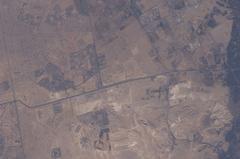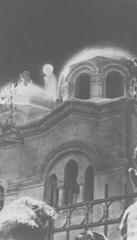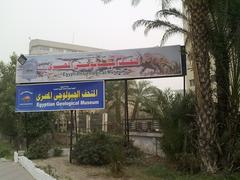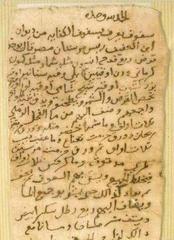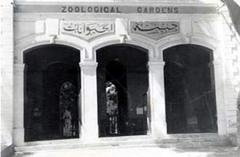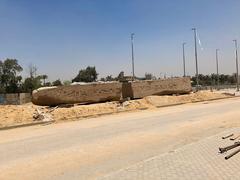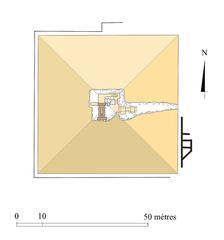Mazghuna Visiting Hours, Tickets, and Historical Sites in Giza Governorate, Egypt
Date: 03/07/2025
Introduction to Mazghuna: Giza Governorate’s Hidden Gem
Mazghuna, an archaeological site quietly nestled approximately 5 kilometers south of Dahshur and 30–40 kilometers southwest of Cairo, offers a rare glimpse into the twilight of Egypt’s Middle Kingdom. Unlike the world-renowned pyramids at Giza, Mazghuna’s two unfinished pyramids—likely intended for Pharaoh Amenemhat IV and the pioneering female pharaoh Sobekneferu—remain largely untouched by mainstream tourism, preserving an atmosphere of raw antiquity. These monuments, with their massive quartzite burial chambers and intricate subterranean passageways, reflect a period of shifting power and innovation during the decline of centralized authority in ancient Egypt (Memphis Tours; Landioustravel).
Mazghuna’s isolation and rugged terrain make it a compelling destination for Egyptology enthusiasts and adventurous travelers. Its proximity to other celebrated sites—such as Dahshur and Saqqara—enables visitors to deepen their understanding of Egypt’s pyramid-building legacy far beyond the familiar tourist trails (Trek Zone; Egyptian Ministry of Tourism and Antiquities).
This guide provides a detailed overview of Mazghuna’s historical significance, archaeological features, visitor information, travel tips, nearby attractions, accessibility considerations, and cultural context. Whether you’re seeking academic insights or an off-the-beaten-path adventure, Mazghuna promises a rewarding journey into Egypt’s enigmatic past.
Table of Contents
- Introduction to Mazghuna
- Historical Context
- Archaeological Exploration & Preservation
- Practical Visitor Information
- Nearby Attractions & Suggested Itineraries
- Cultural Insights & Responsible Tourism
- Frequently Asked Questions (FAQ)
- Conclusion & Visitor Recommendations
- References
Historical Context: The Mazghuna Pyramids
Construction & Attribution
Mazghuna is renowned for its two unfinished pyramids, typically attributed to the late 12th or early 13th Dynasty. The Northern Pyramid is often linked to Sobekneferu, Egypt’s first confirmed female pharaoh, while the Southern Pyramid is associated with Amenemhat IV. However, the absence of inscriptions makes definitive attribution challenging (Memphis Tours).
Both pyramids were abandoned before completion. Only the substructures and lower masonry remain, while the superstructures were never built—likely due to political instability or abrupt dynastic transitions. Despite their incomplete state, the pyramids’ architectural designs exhibit advanced engineering, particularly in their use of colossal quartzite blocks and sophisticated blocking systems intended to deter tomb robbers.
Subterranean Architecture
The most distinctive feature of Mazghuna’s pyramids is their subterranean complexity. Both pyramids possess intricate networks of corridors and chambers, with massive quartzite monoliths used for the burial chambers—some weighing over 30 tons. The Northern Pyramid contains a U-shaped corridor and a monumental quartzite sarcophagus sealed with a 42-ton stone slab, reminiscent of the engineering seen in Amenemhat III’s Hawara pyramid (Landioustravel).
Artifacts and Absence of Burials
No royal mummies or substantial grave goods have been uncovered at Mazghuna, and very few artifacts remain. Excavations by Flinders Petrie and Ernest Mackay revealed alabaster vessels, kohl pots, and architectural fragments, but no inscriptions or cartouches to confirm ownership. The unfinished nature and lack of burials suggest that the pyramids were abandoned during construction, likely due to the rapid succession of rulers and political upheaval (Memphis Tours).
Mazghuna’s Place in Ancient Egypt
Mazghuna’s monuments mark a transitional era at the end of the Middle Kingdom, as centralized royal power waned and regional autonomy increased. The innovative use of quartzite and security features in the pyramids influenced later royal tombs, laying the groundwork for developments in the Valley of the Kings. If the Northern Pyramid was indeed intended for Sobekneferu, Mazghuna holds additional importance as a testament to female leadership during a turbulent dynastic period.
Archaeological Exploration & Preservation
Early systematic excavations at Mazghuna were led by Flinders Petrie in the early 20th century, resulting in the first detailed maps of the site’s substructures. Modern surveys continue to investigate the chronology and architectural innovations, though the lack of inscriptions leaves many questions unresolved.
Today, Mazghuna faces threats from urban encroachment, looting, and environmental deterioration. Preservation efforts are ongoing but limited, and the site remains largely undeveloped for tourism. Visitors are encouraged to respect the fragile remains and adhere to responsible travel practices (Egyptian Ministry of Tourism and Antiquities).
Practical Visitor Information
Visiting Hours & Tickets
- Hours: Mazghuna is generally accessible during daylight, from 8:00 AM to 5:00 PM. There is no official visitor center, and hours may vary.
- Tickets: As of July 2025, there is no formal ticketing system. Some sources report an entry fee of around 60 EGP for foreigners, but travelers should verify with local authorities or tour operators.
Getting There & Accessibility
- Location: About 5 km south of Dahshur, reachable via the Cairo–Faiyum Desert Road.
- Transport: Public transport is sparse. The best options are private car, taxi, or joining a guided tour from Cairo or Giza.
- Accessibility: The site’s terrain is uneven with no developed paths; it is not suitable for visitors with mobility challenges.
Travel Tips
- Best Time to Visit: October–April, when temperatures are cooler.
- What to Bring: Water, snacks, sturdy closed-toe shoes, sun protection, and a camera.
- Safety: Travel with a companion or guide, notify someone of your plans, and carry a charged mobile phone. There are no on-site facilities or medical support (UK FCDO).
Guided Tours
Guided tours are highly recommended for context and safety, especially due to the site’s remote location and lack of signage. Some specialized operators in Cairo or Giza offer off-the-beaten-path archaeological excursions.
Nearby Attractions & Suggested Itineraries
Mazghuna’s proximity to other major sites makes it ideal for a multi-site day trip:
- Dahshur Pyramids: Home to the Bent and Red Pyramids, just north of Mazghuna (Trek Zone).
- Saqqara: The Step Pyramid of Djoser and extensive necropolis, about 20 km north.
- Giza Plateau: The Great Pyramids and Sphinx, further north but accessible for a full-day itinerary.
Combining Mazghuna with these sites provides a broader perspective on Egypt’s pyramid-building history.
Cultural Insights & Responsible Tourism
Local Community
Mazghuna village is a small, agricultural community near the archaeological site. Visitors may encounter local farmers and see a Coptic cemetery, reflecting the area’s diverse spiritual heritage.
Cultural Etiquette
- Dress modestly, covering shoulders and knees.
- Use simple Arabic greetings (e.g., “Sabah el khair”).
- Ask permission before photographing people or private spaces.
- Do not climb on or disturb archaeological remains.
Sustainable Tourism
Support local businesses, avoid removing artifacts, and stay on designated paths to help preserve Mazghuna’s fragile ruins. Community-based tourism initiatives provide authentic experiences while benefiting the local economy.
Frequently Asked Questions (FAQ)
Q: What are Mazghuna’s visiting hours?
A: Typically 8:00 AM to 5:00 PM; there is no official visitor center, so visit during daylight.
Q: Are tickets required?
A: Currently, there is no formal ticketing system. Some sources mention an entry fee, but verify locally before visiting.
Q: How do I get to Mazghuna?
A: Best reached by private car, taxi, or guided tour from Cairo or Giza. Public transport is limited.
Q: Is Mazghuna suitable for visitors with mobility issues?
A: No, the site is rugged and lacks accessible paths.
Q: Are guided tours available?
A: Yes, but they are best arranged through specialized operators or local guides.
Q: Can I take photographs?
A: Yes, but always seek permission before photographing people or sensitive areas.
Q: What is the best season to visit?
A: October to April, for cooler weather and more comfortable exploration.
Conclusion & Visitor Recommendations
Mazghuna stands as a testament to the ambitions and challenges of Egypt’s Middle Kingdom rulers. Its unfinished pyramids, sophisticated subterranean structures, and palpable sense of antiquity offer a powerful experience for those seeking to connect with Egypt’s heritage beyond the famous landmarks. Due to its remote location and minimal facilities, careful planning is essential—preferably with the assistance of a knowledgeable guide.
Combining Mazghuna with visits to Dahshur, Saqqara, or the Giza Plateau provides an unparalleled journey through the evolution of pyramid construction and the complexities of ancient Egyptian society. Visitors are urged to travel responsibly, respect local customs, and support preservation efforts to ensure Mazghuna remains accessible for future generations.
For real-time updates, travel tips, and guided tour options, consider downloading the Audiala app and following official resources and trusted travel platforms.
References and Official Sources
- Memphis Tours: Pyramid of Mazghuna
- Egyptian Ministry of Tourism and Antiquities
- Landioustravel: Mazghuna Necropolis
- Trek Zone: Northern Mazghuna Pyramid
- Official Giza Plateau Visitor Information
- Learn More About Dahshur Pyramids
- UK FCDO: Egypt Travel Advice

